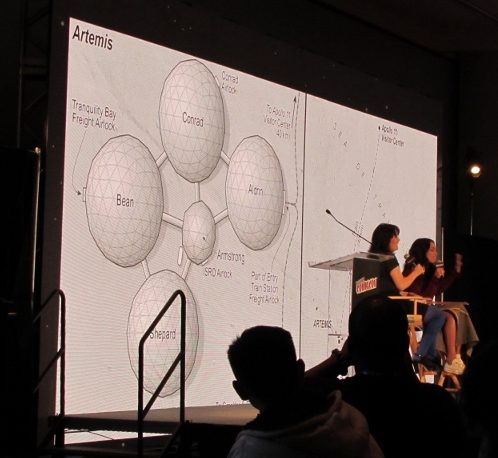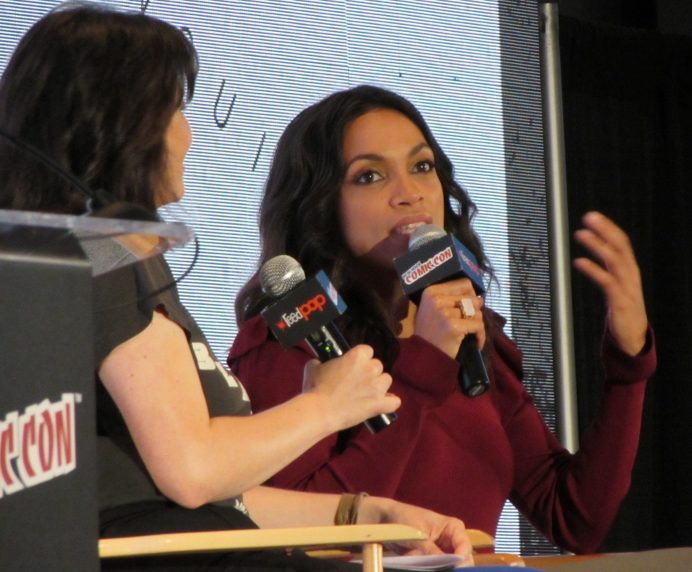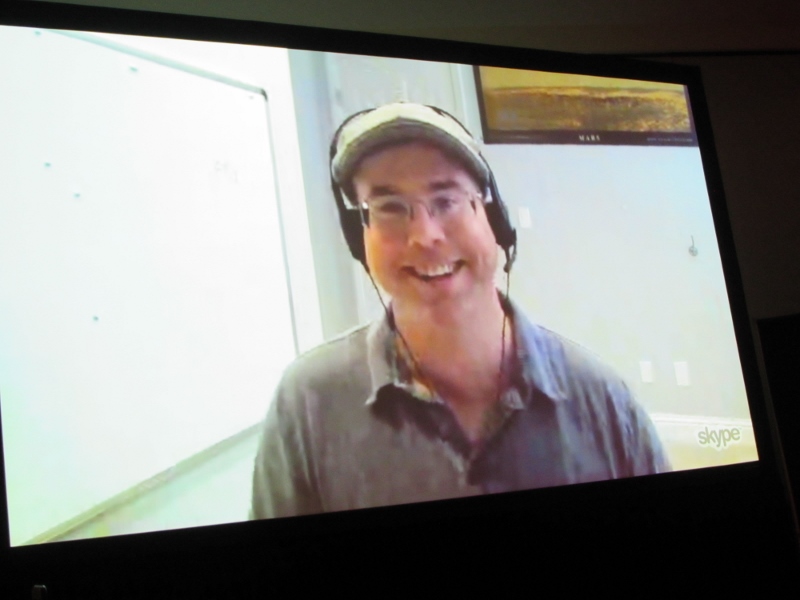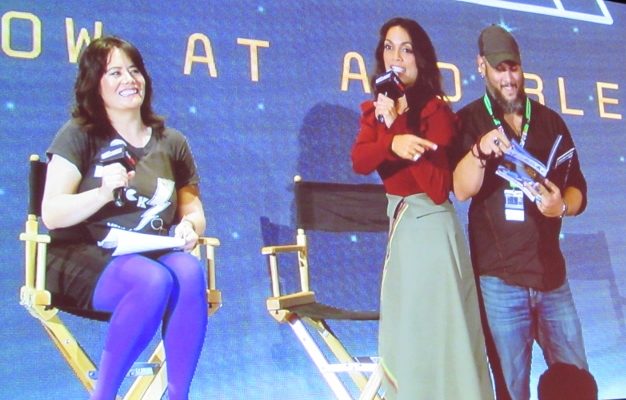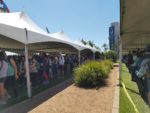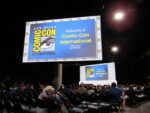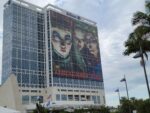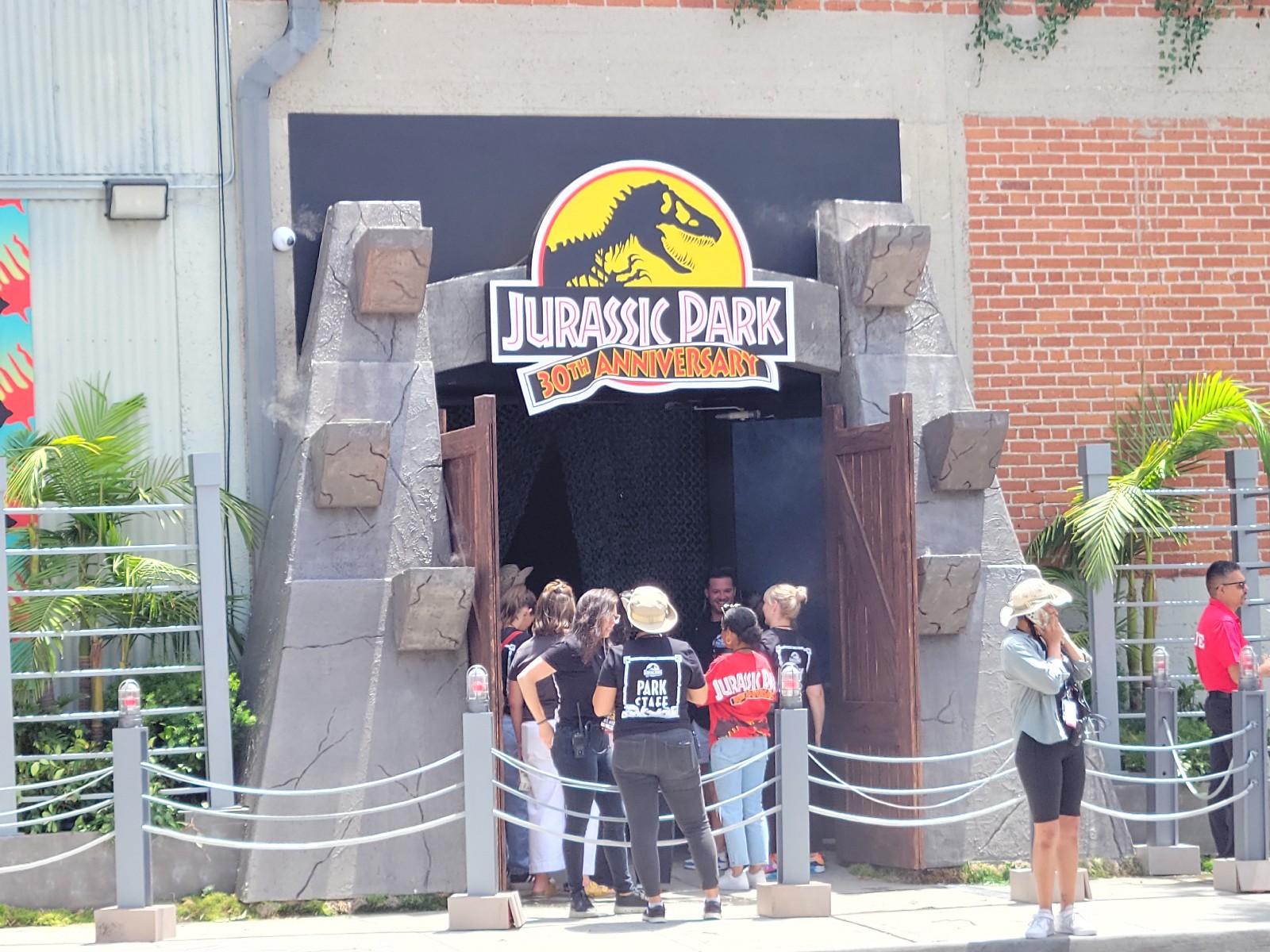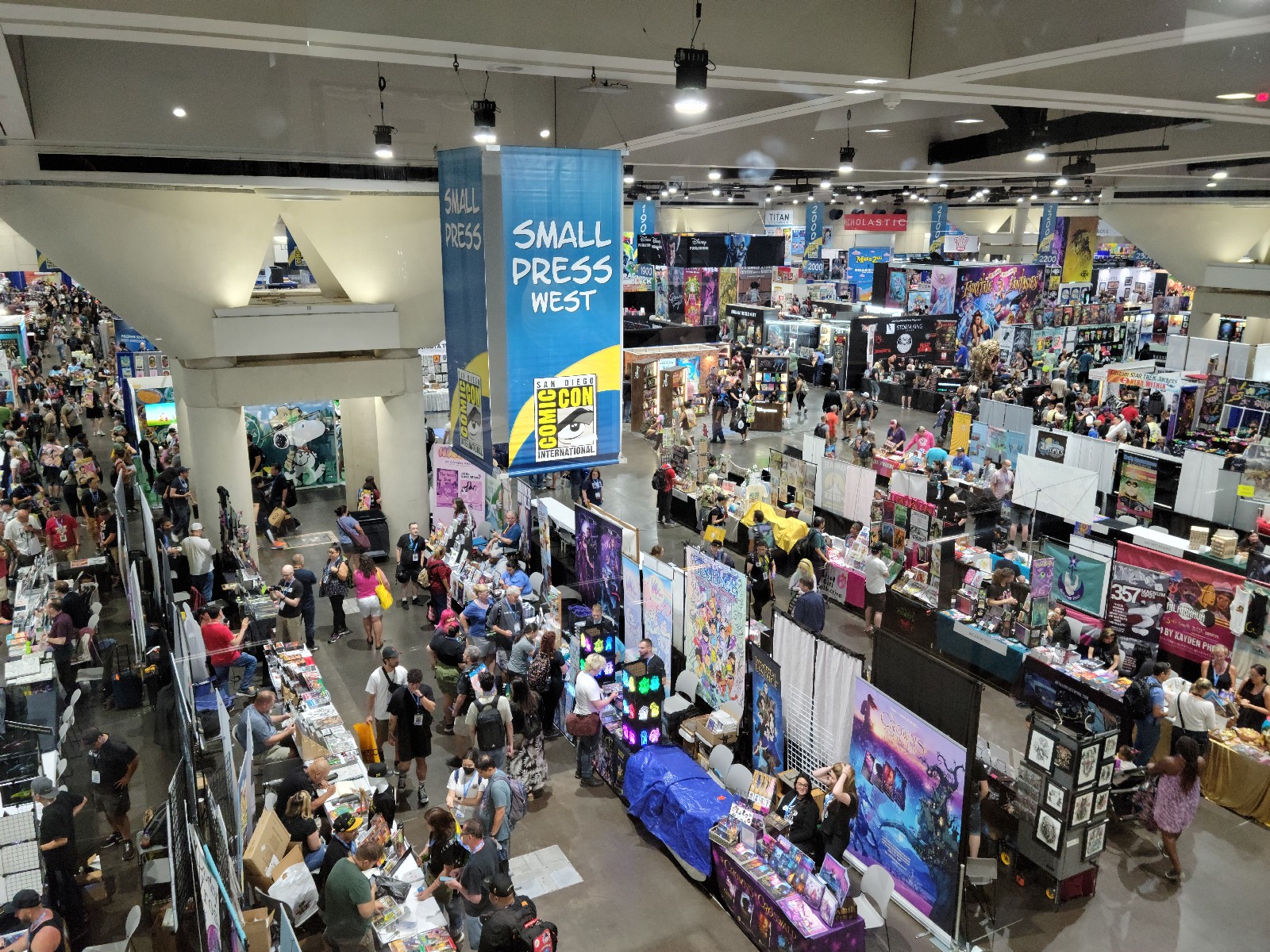After we finished up with walking the Show Floor at New York Comic Con 2017 on Thursday, October 5, we headed down to find panel room 1A06. It was a little confusing, walking downstairs and down hallways, but we finally found it. There was already a bit of a queue waiting outside, so we went ahead and got in line, even though we were about 45 minutes early. Coming from a San Diego Comic-Con mentality, we didn’t know how early to line up for panels at NYCC, especially when Keanu Reeves would be appearing at the end of the day in a small room that isn’t cleared between panels.
Other than doing the War for the Planet of the Apes motion capture experience, and the Amazon Echo Escape Room, seeing Keanu Reeves was my third main goal. The good news was, there were other interesting panels going on in the same panel room earlier in the day. The first of those panels was about Artemis, author Andy Weir’s follow up novel to The Martian. Audible was promoting its exclusive audiobook version of the novel that is narrated by Rosario Dawson.
The panel began with a clip from Artemis, read by Rosario Dawson.
Andy Weir Skyped in from Sunnyvale, California, while Rosario Dawson sat on stage. The moderator announced that the audiobook would be released on Audible on November 14. Rosario commented that she actually has never met Andy, and Andy pointed out that the two never even spoke to each other until this moment.
Because the backdrop of the stage was digital, they then changed the background to be a map of Artemis.
Rosario spoke about how she became involved. She had done the voice of LEGO Batgirl, and Wonder Woman, but she had never done an audiobook. They contacted her to do so, and she thought it would be a great opportunity. There were some scheduling conflicts, so she didn’t have a chance to read it beforehand, so she went in and did a cold reading — at which point she realized there was a lot of technical jargon and accents.
Andy then explained the map of Artemis that we were looking at and said that all the bubbles were named after Apollo astronauts, in the order in which each astronaut walked on the moon. Therefore Armstrong was the first bubble, Aldrin was the second, and so on. Armstrong is industry, Aldrin is the tourist center with casinos and such, while Conrad, where the main character lives, is where the blue collar, middle class people live. Meanwhile, Shepard is where the really rich people live.
Andy further explained that he’s always loved crime capers, and he’s a science fiction author, so he figured “por que no las dos,” and created a crime caper on the moon. We learned that Artemis takes place in the late 2080s. Earth is fine, but Artemis, which is a city on the moon, exists because there is an “economic reason” for it to. It’s his take on where the commercial space industry could go if lunar tourism became more affordable for the middle class.
Rosario talked about recording 70+ pages per day, during which her brain would start feeling dyslexic. However, she felt very drawn into the story, and compared the main character to Matt Damon’s character in The Martian. Jasmine (“Jazz” for short), who is Saudi Arabian, immigrated to the moon with her family when she was 6. She doesn’t feel like Earth is her home. The moon is her home. Rosario, a native New Yorker, also compared having New York street smarts to the kind of skills that Jazz has on the moon. She liked how incredibly sharp Jazz was.
Andy based the class structure on the moon on resort towns such as exist in the Caribbean. He also admitted that Artemis went through a lot of revisions, and originally it had a very different story and set of characters, where Jazz was merely a tertiary character. But it wasn’t coming together well, so he scrapped it and came up with a new concept.
Rosario revealed that she also had done a cold reading for LEGO Batgirl, so it wasn’t really a new concept for her. However, when she was brought in to do Artemis, she thought she was just going to do the narration and others were going to do the characters’ voices. She didn’t realize she would be doing the voices for all the characters! But she enjoyed the experience, and over time, figured out what she wanted to do to make the voices better. For example, if a character was running, she would make it sound like they were panting.
We then listened to another clip from the audiobook, which included Rosario doing accents. She commented that she had to do several different accents, such as Norwegian and Hungarian, which she said makes sense would exist in a tourist town. Rosario further explained that she had a dialect coach come in and help her with the accents, and that she kept being told to pull it back a little, because with audiobooks they more want to “suggest” the accent. The dialect coach hadn’t done that many accents in one day before, so it was really fun for her as well.
Andy said that he wrote The Martian over 3 years at his own pace. But then Random House asked him for his next book. He had one that he got pretty far in, but realized that it wasn’t very good, so he got them to extend his deadline another year, wherein he wrote Artemis, which he said is much better than the other book would have been. He also talked about hanging out with George R. R. Martin, and telling him that he felt like his next book wouldn’t be as good as The Martian. However, George told him, “That feeling never ends,” and that he could be working on his 28th book and still feel that way.
He also talked about finding out that Artemis would be a movie. Andy was in London and his agent called, saying Fox wants the rights to Artemis — now. It was for a purchase, not just an option. He recently found out that Lord and Miller are going to direct it. The next step is to find a screenwriter and go from there. He said he didn’t want to try to adapt his own novel to a screenplay, because it’s all about cramming everything down into a script, which means he would have to decide which of his “children” to cut.
Rosario praised how descriptive Andy is with his writing, saying that she had never seen the map of Artemis before, but that it was exactly as she had pictured it. She went on to say that Andy had a great way of adding in a character’s backstory without making it seem like exposition. Andy commented that sneaking in exposition is one of the hardest things to do. For example, if a story takes place in Chicago, he could just say “Chicago” and people would know what it means. But when it’s a city on the moon, it’s a challenge of how to figure out the best time to tell people about certain things.
We then listened to another audioclip, this time with more technical language, talking about the temperature of coffee on the moon due to the lower boiling point.
Andy also talked about a character who would be in a wheelchair on Earth, but because the moon is 1/6 of the Earth’s gravity, is able to walk around on crutches on the moon. Another thing that Rosario found interesting was that fire was contraband. She went on to talk about how different things are on the moon for someone who has lived there since she was 6 years old as compared to someone who comes there for just a couple of weeks, and how a person who has only ever known the environment of the moon has different instincts. Rosario liked how Andy was able to convey such technical information through situational examples.
Andy went on to talk about how it’s a vacuum on the moon, and that there’s no weather. As a result, any tracks left behind don’t go away. So this is something that Jazz has to account for in the book.
It was then opened up for audience questions, and people were able to line up at a microphone to ask their questions.
One question was about how to bring science and art together. Rosario answered that it’s a matter of investing in it, and making sure it’s a priority in our schools, so as to encourage the childlike curiosity and keep it going, because so much of science is in the “possibility” of something, which leads to the discovery of new things.
Another audience member asked Rosario what her favorite sci-fi movie is. Rosario struggled to find an answer for a few moments, but ultimately answered, “Get away from her you bitch! It would have to be Aliens.” Additionally, she said she just re-watched Avatar, which she loved because it is science and imagination put together, and also about our environment and getting along with it.
The next person asked Rosario if she could go anywhere besides Earth, such as Mars or the moon, where would she go? Andy jumped in, commenting, “Bear in mind, you’ll die immediately!” Rosario then commented that she would like to go to Saturn. She then went on to say that she’s on the Board of the Lower East Side Girls Club, which has the only planetarium in NYC besides the Natural History Museum, where she was just recently looking out into space.
As for whether there were any technical aspects that she had to look into because of the book, Rosario answered compounds, as they seem to come up a lot.
Another question, that might have been a plant, asked Rosario what drew her to all these comic book and sci-fi properties. She then called her Uncle Gus, Gustavo Vasquez, up on stage, who is a comic book artist who has worked on “everything.” Rosario said she grew up reading comic books while sitting back to back with him. However, she wasn’t allowed to touch the pages. Then he would put the comics back in their plastic sleeves afterward. As a result, she grew up as comics being “sacred texts.”
Wrapping up the panel, an Artemis Museum of the Moon was announced, which would be open only from Friday to Sunday, wherein there would be an exhibit displaying what the moon would look like if you were able to see it up close and personal. We were actually able to stop by and check it out that Saturday. Click here to see what it was like!
Up next in Room 1A06 was the Viz Media panel, followed by the Cult of Chucky panel, and then the Replicas panel with Keanu Reeves! We’ll have recaps and photos up on the site soon.
You can view more photos from the Artemis panel at NYCC 2017 below.


